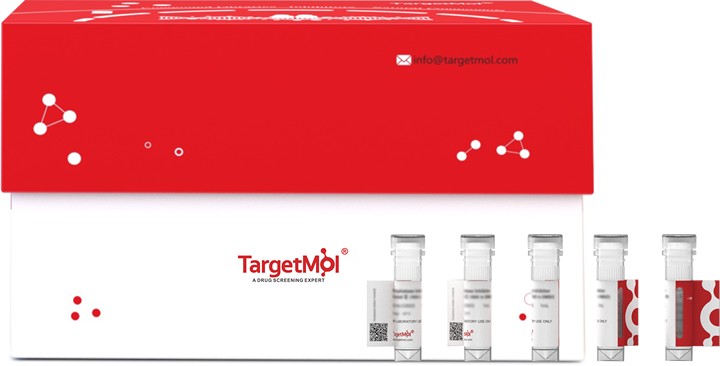 您的购物车当前为空
您的购物车当前为空
APCDD1 Protein, Human, Recombinant (hFc)
一键复制产品信息Osteosarcoma (OS) is the most common type of bone tumor in children and adults. The expression of APCDD1, a Wnt antagonist, was reduced in OS tissues and cells compared to adjacent normal tissue and osteoblast cells, respectively. Mechanistically, this was due to increased levels of methylation in the promoter region of the APCDD1 gene. Consistently, the DNA methyltransferase inhibitor 5-AZA-dC, reduced DNA methylation in the APCDD1 promoter, and restored APCDD1 expression in OS tissue and cells. Moreover, DNMT3a, but not DNMT1 or DNMT3b, was the major DNA methyltransferase that facilitated hyper-methylation of DNA in the APCDD1 promoter, thus reducing APCDD1 mRNA levels in OS tissues. Importantly, ectopic expression of APCDD1 suppressed activity of the Wnt/beta-Catenin signaling pathway in OS cells and inhibited their invasion and reversed their EMT-like properties, while depletion of APCDD1 promoted invasion and metastasis of osteosarcoma cells in vitro and in vivo. That APCDD1 modulates the gene expression of Wnt- and EK-related signaling molecules at the cap stage of tooth development, and is involved in tooth cusp patterning by modulating the epithelial rearrangement in the IEE. In hair follicle cells APCDD1 inhibits the canonical WNT/beta-Catenin pathway and its inactivation is associated with an autosomal dominant form of hair loss. APCDD1 sustains the expression and activation of beta-Catenin.

APCDD1 Protein, Human, Recombinant (hFc)
一键复制产品信息| 规格 | 价格 | 库存 | 数量 |
|---|---|---|---|
| 5 μg | ¥ 493 | 6-8日内发货 | |
| 10 μg | ¥ 790 | 6-8日内发货 | |
| 20 μg | ¥ 1,330 | 5日内发货 | |
| 50 μg | ¥ 2,580 | 5日内发货 | |
| 100 μg | ¥ 5,170 | 5日内发货 |
产品信息
| 生物活性 | Immobilized Human APCDD1, hFc Tag at 2 μg/ml (100 μl/well) on the plate. Dose response curve for Biotinylated Anti-APCDD1 Antibody, hFc Tag with the EC50 of 21.0 ng/ml determined by ELISA (QC Test). |
| 产品描述 | Osteosarcoma (OS) is the most common type of bone tumor in children and adults. The expression of APCDD1, a Wnt antagonist, was reduced in OS tissues and cells compared to adjacent normal tissue and osteoblast cells, respectively. Mechanistically, this was due to increased levels of methylation in the promoter region of the APCDD1 gene. Consistently, the DNA methyltransferase inhibitor 5-AZA-dC, reduced DNA methylation in the APCDD1 promoter, and restored APCDD1 expression in OS tissue and cells. Moreover, DNMT3a, but not DNMT1 or DNMT3b, was the major DNA methyltransferase that facilitated hyper-methylation of DNA in the APCDD1 promoter, thus reducing APCDD1 mRNA levels in OS tissues. Importantly, ectopic expression of APCDD1 suppressed activity of the Wnt/beta-Catenin signaling pathway in OS cells and inhibited their invasion and reversed their EMT-like properties, while depletion of APCDD1 promoted invasion and metastasis of osteosarcoma cells in vitro and in vivo. That APCDD1 modulates the gene expression of Wnt- and EK-related signaling molecules at the cap stage of tooth development, and is involved in tooth cusp patterning by modulating the epithelial rearrangement in the IEE. In hair follicle cells APCDD1 inhibits the canonical WNT/beta-Catenin pathway and its inactivation is associated with an autosomal dominant form of hair loss. APCDD1 sustains the expression and activation of beta-Catenin. |
| 种属 | Human |
| 表达系统 | HEK293 Cells |
| 标签 | C-hFc |
| 蛋白编号 | Q8J025 |
| 别名 | HYPT1,HTS,HHS,FP7019,DRAPC1,B7323,adenomatosis polyposis coli down-regulated 1 |
| 蛋白构建 | Leu27-His492 |
| 蛋白纯度 | > 95% as determined by Bis-Tris PAGE |
| 分子量 | 80.06 kDa (predicted); 82-110 kDa (reducing conditions) |
| 内毒素 | < 1.0 EU/μg of the protein as determined by the LAL method. |
| 蛋白性状 | Lyophilized powder |
| 缓冲液 | Lyophilized from 0.22 μm filtered solution in PBS (pH 7.4). Normally 8% trehalose is added as protectant before lyophilization. |
| 复溶方法 | Reconstitute the lyophilized protein in distilled water. The product concentration should not be less than 100 μg/ml. Before opening, centrifuge the tube to collect powder at the bottom. After adding the reconstitution buffer, avoid vortexing or pipetting for mixing. |
| 存储 | It is recommended to store recombinant proteins at -20°C to -80°C for future use. Lyophilized powders can be stably stored for over 12 months, while liquid products can be stored for 6-12 months at -80°C. For reconstituted protein solutions, the solution can be stored at -20°C to -80°C for at least 3 months. Please avoid multiple freeze-thaw cycles and store products in aliquots. |
| 运输方式 | In general, Lyophilized powders are shipping with blue ice. |
| 研究背景 | Osteosarcoma (OS) is the most common type of bone tumor in children and adults. The expression of APCDD1, a Wnt antagonist, was reduced in OS tissues and cells compared to adjacent normal tissue and osteoblast cells, respectively. Mechanistically, this was due to increased levels of methylation in the promoter region of the APCDD1 gene. Consistently, the DNA methyltransferase inhibitor 5-AZA-dC, reduced DNA methylation in the APCDD1 promoter, and restored APCDD1 expression in OS tissue and cells. Moreover, DNMT3a, but not DNMT1 or DNMT3b, was the major DNA methyltransferase that facilitated hyper-methylation of DNA in the APCDD1 promoter, thus reducing APCDD1 mRNA levels in OS tissues. Importantly, ectopic expression of APCDD1 suppressed activity of the Wnt/beta-Catenin signaling pathway in OS cells and inhibited their invasion and reversed their EMT-like properties, while depletion of APCDD1 promoted invasion and metastasis of osteosarcoma cells in vitro and in vivo. That APCDD1 modulates the gene expression of Wnt- and EK-related signaling molecules at the cap stage of tooth development, and is involved in tooth cusp patterning by modulating the epithelial rearrangement in the IEE. In hair follicle cells APCDD1 inhibits the canonical WNT/beta-Catenin pathway and its inactivation is associated with an autosomal dominant form of hair loss. APCDD1 sustains the expression and activation of beta-Catenin. |





 |
|